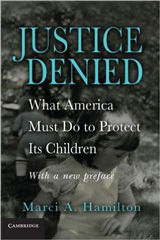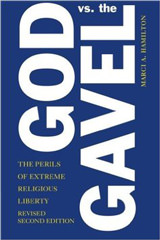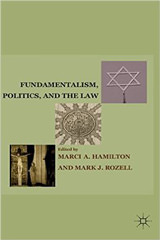On November 19, the United States Court of Appeals for the Second Circuit considered a case that is at the heart of the cultural struggle over entitlements for religious organizations: Bronx Household of Faith v. Board of Education.
At issue in the case is whether the New York City Board of Education can, pursuant to its policy, exclude houses of worship from occupying public schools. The case has bounced around the Second Circuit for a decade. The Second Circuit upheld the policy in a well-reasoned opinion, but U.S. District Judge Loretta Preska, a President George H.W. Bush appointee, surprisingly held on remand that the policy violated the Free Exercise and Establishment Clauses.
Given the earlier ruling by the Second Circuit, the Department of Education argued that res judicata ought to govern the case and that the District Court’s (that is, Judge Preska’s) decision was illegitimate on this procedural ground. Thus the judges could well go the res judicata route and decline to issue a new Establishment Clause decision. Their questions at oral argument, however, indicated a deep interest in the substantive issues. And, why wouldn’t they be interested? The issues are fascinating, and the extreme position that is being taken by the church is brazen. The church’s position, in a nutshell, is that it has a constitutional right to establish a house of worship in a public school.
For ten years, Bronx Household of Faith has been worshipping at a New York public school on the weekends, as it has obtained injunctions to prevent its removal pursuant to the Board of Education policy. At this point, it is arguing that it cannot afford to be anywhere else, because the public-school space is less expensive than comparable commercial space. Part of this case, therefore, is about a demand for government subsidization of houses of worship.
The Growing Demand for Government Entitlements by Religious Groups
There has been a growing demand by religious groups for government largesse. Pres. George W. Bush established the White House’s Faith-based Initiative, which gives federal funds to religious groups to provide social services—even though religious social service delivery groups were already being largely underwritten by government funds.
For example, well over 60% of Catholic Charities’ funding comes from local, state, and federal governments. Catholic Charities, though, was required to keep its religious mission separate from the government funds being provided. It could not discriminate in hiring, and could not use the funds it received for, say, proselytizing or worship. The Faith-based Initative, though, was intended to provide the funds without the checks and balances on funding that had previously applied, and under an Executive Order signed by President Bush and never revoked, religious organizations receiving funds through this new funding avenue could discriminate in hiring based on religion.
At first, conservative groups like Jerry Falwell’s Liberty Fund eschewed government funding, but once the federal spigot opened, they, like many others, viewed it as found money and willingly took it. This was a central insight of conservatives in the Reagan era: Once government funds are provided, they become entitlements. How ironic it is for conservative religious organizations, now so closely aligned with the Republican Party, to stand in line for such a pipeline of funds. That transformation only provides more evidence of how certain religious organizations have sidetracked the Republican Party away from its financial bona fides. The Bronx Household case involves yet another example of a conservative set of religious organizations pushing the envelope to obtain more benefits from the government, with the former Alliance Defense Fund (now the Alliance Defending Freedom) representing Bronx Household and Christian Legal Society filing an amicus brief for numerous religious organizations).
Conservative religious organizations have been chipping away at the Establishment Clause’s rule against government funding for religious activities for years. In the 1995 Supreme Court case of Rosenberger v. University of Virginia Board of Rectors, an evangelical student group demanded the right to public university funds for its religious publication and organization. The University argued (though, inexplicably, it later withdrew that argument) that funding proselytization was a violation of the Establishment Clause. In a 5-4 decision, the Supreme Court upheld the religious organization’s right to receive University funding on the same grounds as any other student group. It is critical, here, to note that the case was not about the right of the organization to exist, distribute its message, or hold meetings on campus. Rather, the issue was whether a state university was required to underwrite the club’s activities.
In 2000, the Supreme Court decided Mitchell v. Helms, in which Americans United for Separation for Church and State argued that it was a violation of the Establishment Clause for the government to provide computers to parochial schools. A fractured Court held that it was permissible. The four most conservative members of the Court (Chief Justice Rehnquist and Justices Thomas, Scalia, and Kennedy) believed that the government can give valuable items to religious organizations so long as, at the time the item was handed over, there was no indication that the organization intended to use the item for religious purposes. Justice O’Connor, joined by Justice Breyer, was more concerned about the potential for using the computers for religious ends, but saw no evidence of inappropriate use in that case. At base, the Court was in disagreement over what financial assistance to religious organizations crosses the Establishment Clause barrier, but the conservative Justices made their intentions known.
In the Supreme Court’s 2010 decision in Christian Legal Society v. Martinez, the CLS attempted to expand the holding of Rosenberger to mean that a religious group not only could receive funds on the same grounds that every other campus organization receives such funds, but also could discriminate in ways no other organization could, and still receive the funds. In that case, the Hastings Law School declined to fund CLS’s student organization because it discriminated in its leadership positions according to sexual orientation, in violation of state law; CLS is opposed to homosexuals holding leadership positions in the group. Again the issue was money, not the right to operate on campus. Hastings provided space for CLS’s members to meet, bulletin boards that they could use, and freedom to espouse and believe whatever they chose. The only question, then, was whether the school was required to give CLS money on the same terms as it gave it to the other student groups, who could not discriminate. After Hastings denied the funds, CLS sued, arguing that the school’s policy violated its First Amendment rights.
The Supreme Court rejected CLS’s argument, holding that the school’s “all-comers” policy could be enforced even against a religious organization, where the only imposition the organization suffered was a lack of funding. Tellingly, the majority was composed of the Court’s more liberal members, though Justice Kennedy joined. The dissent included the most conservative members, Chief Justice Roberts and Justices Alito, Scalia, and Thomas. Again, the more conservative members of the Court were inclined to require the government to fund religious groups.
In the Bronx Household case with which I began this column, the church—along with other religious organizations asking to use public schools to establish worship centers every weekend—has argued that its First Amendment rights are violated if the school district does not provide it with access to public schools every weekend of every year. While a lot of doctrine was thrown around in the briefs, the crux of the argument, at this point, is that the church says it cannot afford to pay commercial rates for comparable space. Therefore, it contends, denying it access to the public schools burdens its religious conduct.
The New York City public schools do not charge anyone, or any organization, full price for the use of their buildings, willingly subsidizing extracurricular activities for the good of students and their families. In other words, the churches have found a bargain and they want to hold onto it.
The Theological Beliefs Driving the Demand to Occupy Public Schools With Houses of Worship: Church Planting
There is another, theological, element in this case that several amicus briefs documented. Evangelical churches are part of a “church-planting” movement that hopes to occupy public spaces, and particularly public schools, to the maximum extent possible. Based on the record, the Bronx Household church holds such a belief, and is quite proud of having established a “beachhead.” Not only does such “church-planting” effect an enormous financial savings for the church, but, in addition, there is a religious motive behind the creation of this fully-religious presence via the establishment of houses of worship in public schools. There is little question that a church that operates in-house at a public school every weekend for ten years is “planted.” The idea of the movement is for the church to keep growing and expanding, with the limbs of the tree reaching out from inside the public building and school, and into the community in order to draw more co-religionists into the public space. At base, this is a movement to displace the public shared space of many believers, in order to constitute a single public space occupied by only one set of true believers. Those within the movement are seeking to establish their religion, quite literally, in the public schools. No government in the United States can constitutionally participate in, endorse, or support such a movement.
After a decade, it is equally clear that the school district has crossed the line from being a host for an organization, to endorsing a particular religious group. No organization meets 52 weeks per year, rain or shine, in a public school, other than a house of worship. No chess club, sports team, or drama group is meeting on that many weeks of the year. There is an intertwining of presence, message, and purposes in such a hosting situation that is unconstitutional under any commonsense reading of the Establishment Clause.
The Supreme Court, in the crèche cases, invalidated temporary public holiday displays in public spaces, because they violate the Establishment Clause by sending a message of government endorsement of religion. In the 1989 case of Allegheny County v. ACLU, the Court held that a nativity scene placed in a courthouse violated the separation of church and state, because viewers could not separate the deeply religious character of the crèche from the government purposes of the location. That decision was clearly correct, and the facts of that case pale in comparison to the facts in Bronx Household. A temporary display of a nativity scene in a courthouse for holiday purposes is a far cry from a house of worship that is firmly established in a public school for years. It is nonsensical to argue that the impression of entanglement and of endorsement is not clear.
That is, of course, the message that conservative religious organizations intend the people to believe: that the American government is based on religion—Christianity, to be clear about it. This is a theme oft-repeated by those in right-wing religious non-profits, including the ADF, the Christian Legal Society, and the Becket Fund, all of which are involved in this case, either as Plaintiffs’ counsel or supporting amici. For them, there is a necessary symbiosis between government and (their) Christian beliefs. What the Second Circuit has already said in this case, which was solidly based on the doctrine—though its teaching was ignored by Judge Preska—is that such a close and interdependent relationship between church and state violates the Establishment Clause.
What Is a “House of Worship”?
Bronx Household argued that the Board’s term “house of worship” violates the Establishment Clause, because some religious groups don’t really worship. This is just about as silly an argument as I’ve seen in Establishment Clause cases. A house of worship is a place where religious adherents gather to observe their religion, whether there is a deity or not and whether it is through prayer, meditation, or joyful celebration. Decades of land-use law, with which the many religious groups involved in this case—and particularly the Becket Fund are quite familiar, have employed “houses of worship” as a category in ordinary land-use codes. It is a standard category of building use. They don’t argue that it’s unconstitutional when they get the benefit of the category, that’s for sure!
Moreover, uses of land or buildings for houses of worship are uses that are distinct from other religious activities, because they feature the gathering of the faithful and occur on at least a weekly basis, year-round. Historically, when there were established churches in the states, the government usually owned the houses of worship, and some cities with multiple-religious establishments owned the houses of worship, and would determine which religious group would use the building each year. The genius of the Establishment Clause is that it eventually separated these functions to increase religious liberty and freedom from the tyranny that a theocracy imposes. When its arguments are taken altogether, it is clear that Bronx Household of Faith is arguing for a theocracy, not just a subsidized meeting space.
During oral argument before the U.S. Court of Appeals for the Second Circuit, it was evident that Judges Guido Calabresi and Pierre Leval were inclined to rule as the Constitution requires, with due respect for the separation of church and state, if they do not take the res judicata route. Judge Walker, however, appeared to be unpersuadable on the merits, which is unfortunate, as this case has pushed the absolute limit on what public spaces can, or should, permit when it comes to supporting religious groups. It is shocking that any federal judge, who has faithfully read the Supreme Court’s doctrine, would force the doctrine to this extreme.
At bottom, we need to remember that this case is just the next case, among many, in which a religious organization is arguing that the First Amendment entitles it to government financial support and a right to fill the public space with its values and beliefs. This case is just one item on a much longer wish list of ways in which the government can support religious institutions. Another major item on the list is to divert public funds from the public schools to religious private schools. Even in the First Amendment context, it pays to follow the money to know what is really at stake.









